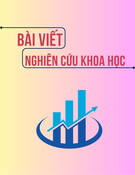
TRƯỜNG ĐẠI HỌC VĂN LANG
KHOA: Quản trị kinh doanh
ĐỀ THI VÀ ĐÁP ÁN ĐỀ THI KẾT THÚC HỌC PHẦN
Học kỳ 3, năm học 2021 - 2022
Mã học phần: Corporate Social Responsibility and Business Ethics
Tên học phần: Trách nhiệm xã hội của doanh nghiệp và đạo đức kinh doanh
Mã nhóm lớp học phần: 213_7QT0220_01
Thời gian làm bài (phút/ngày): 90 phút
Hình thức thi: Trắc nghiệm kết hợp tự luận
ĐỀ THI (ĐỀ 1)
Part I/ Multiple choice questions
Question 1: Business ethics refers to:
A. Principles and standards that guide behavior in the business world
B. Companies refraining from forming monopolies or restricting competition in any way
C. Regulations and laws that guide companies in their business decisions
D Unique industry and professional factors that influence employees
ANSWER: A
Question 2: Which of the following best describes social responsibility?
A. Adoption by a business of a strategic focus for fulfilling the economic, legal, ethical,
and philanthropic responsibilities expected of it by its stakeholders
B. A corporation’s rights, such as due process in a court of law, freedom of speech, and
privacy
C. A company’s attempt to maximize its profits in order to benefit stockholders
D. All the policies of a company that promote ethical business practices
ANSWER: A
Question 3: Those groups to whom a company is responsible are collectively known as
A. Stakeholders
B. Society
C. Employees and customers
D. Stockholders
ANSWER: A

Question 4: Implementing social responsibility on a global level is complex because
A. There is a need to balance economic responsibility with other responsibilities
B. Consumers in most countries do not care about social responsibility
C. Employees speak many languages and some information is hard to translate
D. Global companies are rarely subject to local laws and regulations
ANSWER: A
Question 5: Why may CSR initiatives tend to gain more attraction in affluent societies?
A. Consumers in developed societies expect more from the companies whose products
they buy
B. Consumers in developing countries do not care about CSR issues
C. Corporations in affluent societies can spend more money on CSR initiatives
D. Businesses in developing countries do not have competition and, thus do not need to
have CSR initiatives
ANSWER: A
Question 6: Which driving force of corporate social responsibility is the most important?
A. The forces are all equally important and work together.
B. Affluence, because without money and care about social issues, CSR initiatives are
uncertain.
C. Communication, because companies must successfully communicate with their
stakeholders to remain profitable.
D. Sustainability, because addressing environmental issues is crucial to the continuing
success of businesses.
ANSWER: A
Question 7: Social media is allowing consumers to ---------------?
A. Interact with firms in real time in ways that shape their purchase decisions
B. Select the most environmentally friendly products
C. Try more products virtually before purchasing
D. Completely understand the CSR of companies
ANSWER: A
Question 8: As societal values evolve, it is likely that the ________ responsibilities of
today may become the _________ responsibilities to tomorrow
A. discretionary, ethical
B. economic, ethical
C. legal, ethical
D. discretionary, economic
ANSWER: A
Question 9: When considering whether or not a company should engage in CSR, it is
important to look at the company values. Some companies believe providing a return to

shareholders is the sole purpose for the existence of the business. In these companies,
believers in CSR will best convince company non-believers with which of the following
arguments?
A. CSR initiatives, for example reducing the company’s environmental footprint, is shown
to reduce costs and add to the bottom line.
B. We can use CSR to build a stronger relationship with our customers
C. It is simply the right thing to do
D. CSR is the new trend, in order to keep up in business, we must implement a CSR plan
ANSWER: A
Question 10: Which following is not one feature that promotes strategic corporate social
responsibility?
A. Companies emphasize short-term benefits
B. Top management should support strategic corporate social responsibility
C. All stakeholders should be responsible to ensure strategic corporate social responsibility
to be effectively implemented
D. Corporate social responsibility activities are integrated into daily operation
ANSWER: A
Question 11: Coca-Cola, Kraft and other food and beverage companies have been accused
of contributing to child obesity in the developed world. This is more likely to be an
example of which pressure enforcing strategic corporate social responsibility?
A. Pressure from the majority
B. Pressure from sustainable trends
C. Pressure from globalization
D. Pressure from mass media
ANSWER: A
Question 12: Which following is not a sustainable trend?
A. Mass production
B. Zero-footprint production
C. Industrial-wide sustainable product index
D. Green material using production
ANSWER: A
Question 13: Why does mass media and communication technology development could be
a pressure for strategic corporate social responsibility?
A. Because this technology is changing how stakeholders interact with firms
B. Because stakeholders can use this technology to spread good news about the companies
C. Because they can increase efficiencies and market-test products
D. Because companies could use viral marketing to advertise their products
ANSWER: A

Question 14: Which is the sustainable development goal of the United Nation?
A. All provided answers are correct
B. Responsible consumption and production
C. Decent work and economic growth
D. No poverty
ANSWER: A
Question 15: Vedan Vietnam and Formosa Vung Ang are examples of which problem that
companies need to care about in their corporate social responsibility agenda?
A. Waste management
B. Low labor cost
C. Working condition
D. Responsible consumption
ANSWER: A
Question 16: Which would be arguments for the opinion that strategic corporate social
responsibility is a good business model?
A. It creates ethical standard, moral awareness, and values for organizations
B. It helps to increase brand loyalty
C. It helps to attract more investment
D. None of the above is correct
ANSWER: A
Question 17: To implement strategic corporate social responsibility, how many main
categories need to consider?
A. 3
B. 2
C. 4
D. 5
ANSWER: A
Question 18: For what reason, non-governmental organizations and non-profit
organizations could effectively assist local government to tackle problem of poverty?
A. As they have accumulated a great of knowledge and know-how for poverty reduction
B. As they have strong financial background
C. As they come from developed countries
D. As they have good will to help the poor.
ANSWER: A
Question 19: Why multinational corporations (MNCs) are important in least-developed
countries?
A. All provided reasons are correct.
B. MNCs exercise procurement, production, and sales in these countries

C. MNCs’ social influence can be at the world level
D. MNCs are expected to enhance the standard of living in these countries
ANSWER: A
Question 20: According to the Economic Pyramid Model, which market could be
considered the place for “reverse-innovation”?
A. Bottom of the Pyramid (poor people)
B. Middle of the Pyramid (middle-income class people)
C. Top of the Pyramid (wealthy people)
D. None of the above
ANSWER: A
Part II/ Essay Questions
Question 1: (2 scores)
Briefly define each of the four driving forces of corporate social responsibility and give
one example for each force. Give your opinion on which of the forces is most important?
Question 2: (3 scores)
Read the case below and answer the corresponding questions.
Employee Volunteer Programs Worldwide
When companies ask for a “bottom line” benefit for implementing a comprehensive
CSR perspective, employee volunteer programs deliver: Today, more corporations are
turning to hands-on volunteer projects to get their people motivated and working as a team.
In many cases, participants say such activities help them forge bonds that remain even after
they return to the office. In terms of employee loyalty and retention, employee volunteer
programs revitalize employees. Such programs expose employees to a new environment
away from their everyday position, allowing them to feel pride in their company and its
standing within the community while also leading to the development of new skill sets:
Marc Benioff, CEO of Salesforce.com, promotes what he calls “the 1 percent solution”: 1
percent of the company’s equity, 1 percent of its profits, and 1 percent of its employees’
paid work hours are devoted to philanthropy.
U.S. software maker SAS, which for six years has been among the Top 20 in
Fortune’s annual list of the 100 best companies to work for, offers a volunteer initiative
that lets employees use flexible schedules to take paid time off for projects in the
community, or even work in teams with their managers on a volunteer effort during
business hours.


























